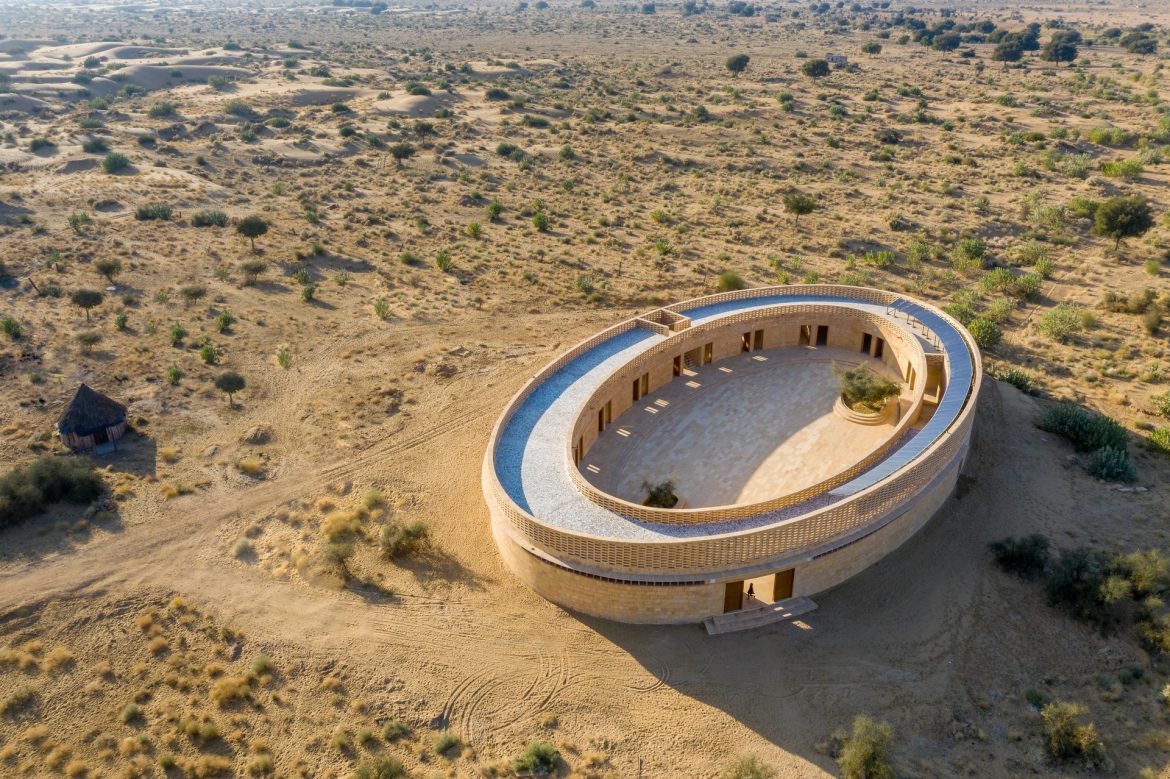
Passive Designs for Natural Air Conditioning
According to the UN’s World Meteorology Agency, we have just left behind the warmest week of humanity’s known history. Record global temperature averages, broken on the 4th, 5th, and 6th of July successively, are the highest since we started recording meteorological data during the 1850s (on 6th July 2023, the average global temperature was 17.23 OC). Scientists from Leipzig University claim that global averages weren’t been this high for 120.000 years, since the last interglacial period. Ocean surface temperatures, similarly, have been breaking records since April 2023.
Considering factors like global warming, climate crisis, greenhouse gases, and El Ninos, experts are almost certain that the following years will witness an increasing trend in global temperature averages and will become ‘normal’ in 2050. Increasing temperatures have an impact both directly and indirectly on human health and the environment, as well as natural ecosystems and biodiversity. According to International Energy Agency’s 2018 report, energy consumed for cooling buildings constituted 20% of total energy consumption globally. As this energy is mostly sourced from fossil fuels, increasing temperatures will result in more fossil fuel consumption, thus greenhouse gas emissions, and the problem will continue to be inflated via a positive feedback loop.
However, before we started relying on fossil fuels so much, we were already using methods and techniques to make the best of environmental conditions in quite efficient ways. Turning natural elements to our advantages, such as water, wind, sun, and shade, and using only ‘passive’ methods, we were able to meet our cooling/heating needs without consuming any external energy source. After the industrial revolution and the technology, it provided, we became addicted to cheap fossil fuels and the lifestyle it brought, and we ‘forgot’ most of these common-sense methods and turned our lives into a never-ending struggle. We even started to call these low-tech passive approaches ‘primitive’. But negative climate events mostly related to wasteful fossil fuel use are becoming more and more serious every passing year. At the same time, we are seeing good examples of ages-old but wise, efficient passive approaches combined with appropriate technologies in order to achieve energy-efficient living spaces. This article will present some passive design methods and examples that reduce or even eliminate heating/cooling needs in buildings.
‘Passive design’ can be defined as an integrated whole of approaches and designs that minimize energy consumption, while increasing the comfort level of occupants in a building by turning local climate conditions into advantages. The aim is to use local climate conditions in the best possible way to eliminate the need for energy consumption by combining various design elements and technologies. This means that there is no single, magical recipe for achieving this energy efficiency in every climate; there are different design approaches for hot, arid, humid, temperate, and/or cool climates. However, there are methods suitable for every climate and at the core of these methods, lie some common principles. For example;
- Location/Orientation: a prerequisite for a successful passive design is the correct orientation. In order to benefit from passive designs in temperate regions of the northern hemisphere, the building’s long axis should be oriented in an east-west direction, windows should be mainly placed on the south-facing side and if possible, no windows (or a minimal amount) should be placed on the west and north-facing sides of the building.
- Passive Ventilation: by orienting the building and placing the windows towards the prevailing wind directions, cross-ventilation can be achieved, or by using ‘thermal chimneys’ to let out rising hot air in the building, the ‘stack ventilation’ effect can be utilized. Regardless of the individual technique, the main aim is to increase the ‘heat loss’ and balance interior and exterior temperatures.
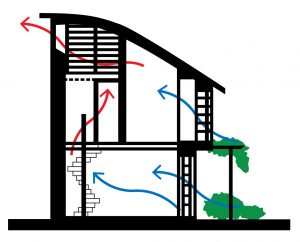
- Shadows: The length of roof eaves of buildings are carefully calculated to block the hot summer sun from entering the house via windows, but let the warm winter sun into the building as much as possible. There are also examples of simple roof mechanisms that can be protracted in summer and folded up in winter to achieve this solar gain effect. It is always better and more efficient to block the sun before it gets inside a house (and using cloth blinds). Careful landscape elements such as walls, trees, and shrubs designed according to summer/winter sun paths can help increase the shade effect, divert the winds through windows and maintain healthy temperatures inside a house. These combined approaches are usually called ‘preventing heat gain.’

- Thermal Mass: high-density materials like stones, rocks, bricks, earth, and concrete absorb excess heat and then release it slowly. These building materials are especially suitable for passive heating systems when used under certain conditions and in certain amounts, but can be useful for passive cooling as well if excess heat stored by the thermal mass can be let out without adding up to interior temperatures. For example, when thermal mass floors are not insulated from the ground beneath and around the building, excess heat can be transferred to the earth, helping keep interior temperatures comfortable.

- Insulation: Building materials with high insulation coefficient can be useful for keeping the inside temperatures warm if used in shaded (north in the northern hemisphere) sides or walls facing cold winds directly, or help keep inside temperatures cool if used in sun-facing (south in the northern hemisphere) walls.

There are of course many more techniques related to passive cooling in buildings and the ones presented here can be explained and detailed further, so this is just an overview. An important thing that needs mentioning here is that it is very expensive, if not impossible, to modify buildings that are already built and completed (without increasing the carbon footprint that the building already has), requiring practices that are not so ‘ecological’. Passive solar designs can be successfully and efficiently implemented in a building only if considered during the design phase of a construction project.
Besides all these, simple cooling fans, especially ceiling fans, can be very efficient in cooling interior spaces. These create much better airflow in the rooms compared to AC units. A study in Australia showed that AC use can be reduced by up to 75% by only using ceiling fans.
Rajkumari Ratnavati Girls’ School, Rajasthan, India
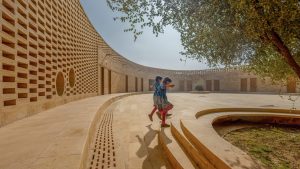
This school, which is located in the city of Jaisalmer in the Thar Desert, is considered to have miraculous design elements. The design process takes into account local climate conditions (up to 50 OC during hot seasons); local sandstone is the main building material, thus with a low carbon footprint; solar PV panels placed on the roof not only provide energy but also provide valuable shade areas; intricate architectural forms prevent sand from entering the central courtyard during sandstorms; natural air flows are efficiently utilized to create passive ventilation in closed spaces; correct use of thermal mass creates efficient heat transfer between the structure and the earth below; and besides harvesting 350 tons of water every year, all these cooling practices require no energy and no AC units running on electricity. The school is not only a technical success but also a social one; more than 400 girls attend classes, where the literacy level among women is quite low in the region. They also learn traditional handcrafts such as weaving. There is a library, a museum, and performance arts spaces in an educational complex, which aims to support a model for sustainable economic independence.
Wind Catchers
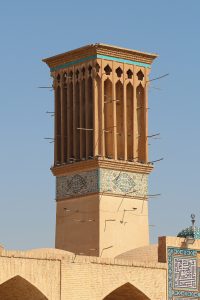
These buildings have been used especially in Iran for harvesting winds in order to keep the inside temperatures of buildings comfortable. They are basically towers with one or more openings directed at prevailing wind directions so they create airflow inside the buildings and cool it down both by cross-ventilation and stack ventilation methods. (Up to 10 OC temperature difference between interior and exterior temperatures.)
Wind catchers are also used to keep food fresh when combined with cellar spaces. They are common in almost all Middle Eastern countries and started to spark interest in modern architectural designs. It is not clear where it originated, but Iran and Egypt are the most probable candidates.
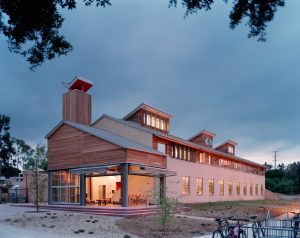
Passive houses in a modern sense first appeared during the fuel crisis in the 1970s. These buildings, which keep cool in summers and warm in winters without any external energy input (thus, passive), became more and more complex with advancing technology and new building materials and in time evolved into various building standards and certifications such as ‘Passivhaus’, ‘LEED’, ‘PHIUS’ and others. However, it doesn’t matter how advanced the technology used, or how novel the building materials are, a building claiming to be a passive solar design should also take into account principles gained by hundreds and thousands of years of observations and experience on how to use local climate conditions in the best way, and place these principles in its core. This is the only way a building can be truly ‘green’ or ‘ecological’ because all ecological design methods place the need to ‘not fight against nature’ and the idea of ‘problem is the solution’ in their hearts.
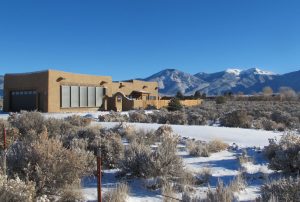
REFERENCES
- 1. https://www.theguardian.com/environment/2023/jul/11/uncharted-territory-un-declares-first-week-of-july-worlds-hottest-ever-recorded
- 2. https://www.newscientist.com/article/2381532-the-past-week-was-the-hottest-ever-recorded-on-earth/
- 3. https://www.iea.org/reports/the-future-of-cooling
- 4. https://www.sciencedirect.com/science/article/pii/S209526351400003X
- 5. https://www.yourhome.gov.au/passive-design/passive-cooling
- 6. https://sustainability.williams.edu/green-building-basics/passive-solar-design/
- 7. https://www.archdaily.com/960824/the-rajkumari-ratnavati-girls-school-diana-kellogg-architects
- 8. https://en.wikipedia.org/wiki/Windcatcher
- 9. https://www.bbc.com/travel/article/20180926-an-ancient-engineering-feat-that-harnessed-the-wind
